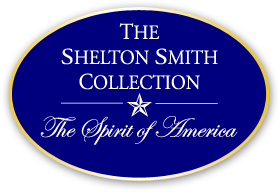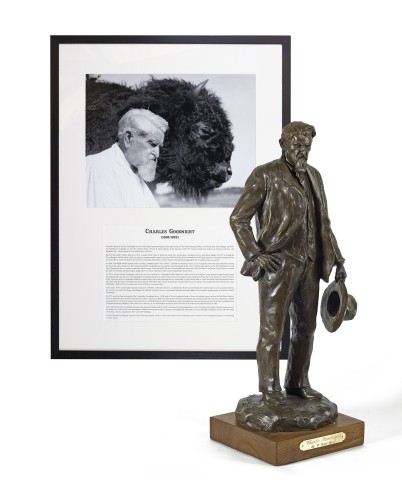The Charlie Goodnight Collection
Artwork Inquiry
CLASSIC EARLY 20TH CENTURY PHOTOGRAPH AND ONE OF ONLY 10 GRANT SPEED BRONZES - A ONE-OF-A-KIND COLLECTION
Charles Goodnight (1836-1929)
Colonel Charles (Charlie) Goodnight was one of the most important figures in the epic history of The Great American West. A cowboy, early Texas Ranger and frontier trailblazer, Goodnight was also the founding father of the U.S. cattle industry. In the later part of the 19th century he built one of the great American ranches – the legendary JA – which spread over a million acres of Texas.
Born in Macoupin County, Illinois in 1836, young Charlie came to Texas ten years later and became a working cowboy and Indian fighter. In 1857 he joined the Texas Rangers. In December 1860, serving as a sergeant under Captain Lawrence Sullivan (Sul) Ross, Goodnight led the fight against a Comanche encampment on the Pease River which resulted in the recovery of Cynthia Ann Parker, a white woman who had been captured by the Comanche 24 years earlier.
In 1866, Goodnight and his partner, Oliver Loving, embarked upon “The Gather,” a statewide round-up of stray Texas Longhorn cattle that had roamed free during the four long years of the Civil War. Once assembled, Goodnight and Loving drove the herd north along what would become known as the The Goodnight-Loving Trail. During this drive Charlie invented the chuck wagon. Soon thereafter, the two Texas trailblazers partnered with New Mexico cattleman John Chisum to extend the trail to Colorado and Wyoming to supply the U.S. Army with beef via the newly established Chisum Trail.
In 1867 Loving, without Goodnight, struck out on a new cattle drive. Although he told Charlie he would travel only at night, Loving became impatient and pushed ahead during the day. He was soon attacked by Comanche and Kiowa raiders and grievously wounded. Upon reaching Fort Sumner, New Mexico, he sent for Goodnight. Upon his arrival, Goodnight found his partner barely alive and promised him he would take Loving’s body back to Texas for burial. After finishing the drive and delivering the herd, Goodnight returned in March 1868 and took Loving’s body back to Weatherford, Texas for burial. This incident became the basis for Larry McMurtry’s Pulitzer Prize winning, epic novel of Texas, Lonesome Dove.
In the early 1870’s, Goodnight married and moved to Pueblo, Colorado where he established the Rock Canyon Ranch. He soon became a very successful Colorado rancher, real estate developer and (despite his inability to read or write), a prominent businessman and banker. Out of respect, people began to call him Colonel Goodnight.
In 1875, upon the final surrender of the Comanche, Goodnight drove 1,500 head of Texas Longhorns back to Texas to establish a new ranch in the Palo Duro Canyon. He soon partnered with wealthy Irish investor John G. Adair to establish the first ranch in the Texas Panhandle, the JA Ranch. By 1883, the JA comprised 1,335,000 acres spread over 6 Texas counties with a herd of over 100,000 head of cattle. During these years Goodnight also saved and preserved one of the last remaining herds of American Bison (Buffalo), which survives to this day. It was this Buffalo stock that was reintroduced to Yellowstone National Park in 1902.
In his later years, Col. Goodnight became close personal friends with the last Comanche Chief, Quanah Parker, son of Cynthia Ann Parker. Despite losing most of his fortune in a 1919 silver mine speculation, Charlie continued to work as a rancher, newspaperman and banker. He also founded a college in Texas. After the death of his first wife, he remarried in 1927 on his 91st birthday.
Colonel Charles Goodnight, legend of the American Frontier, died in 1929 at his winter home in Phoenix and is buried in the Goodnight Cemetery in Armstrong County, Texas.
Artist Bio
Framed photo courtesy of the Panhandle-Plains Museum, text by Shelton Smith.
CHARLES GOODNIGHT by Grant Speed, CA (1930-2011). #4 of an edition of only 10.
Past master Grant Speed, a longtime member of the Cowboy Artists of America, was a traditional sculptor of bronzes of the Old West. Born in San Angelo, Texas in 1930 he later lived in Lindon, Utah. “There is a mystique about the West,” he once observed, “that has captured people in all walks of life throughout the world. In the United States there are movies, television shows, rodeos, books, and magazines all depicting the West. In the midst of this worldwide enthusiasm for the West, there is a growing interest in Western art.”
Raised during the Depression, Grant Speed never doubted that he would be a rancher. At twelve, he began to summer on a ranch that was “the neatest place on earth.” After he graduated from high school at seventeen, he worked as a cowboy on fifteen different ranches. By the time he was twenty-two, despite two hitches in the Air Force, he wasn’t any closer to buying a ranch of his own so he decided to go back to school.
He enrolled in animal husbandry at Brigham Young University, spent two and a half years on a mission for the Mormon Church, was a professional bronco rider in the rodeo until he injured a leg, and in 1962, qualified as a teacher. In two years, he knew he was in the wrong job. He had kept to himself his interest in art, but now he “decided very seriously that I was going to give art everything I had in me.” After teaching school all day, he taught himself to sculpt, and by 1965 he was selling bronzes at Trailside Galleries. The next year he was accepted into the Cowboy Artists of America and his career was established. He was featured in Ainsworth’s The Cowboy in Art in 1968, and then quit teaching. In 1970, the entire edition of his sculpture was sold-out at the CAA show, and in 1976 he won the CAA gold medal. His biography "From Broncs to Bronzes" was published in 1979.
Grant continued to work almost his entire lifetime. He was universally recognized by his peers, collectors and art critics as one of the seminal masters of American Western Art. He passed away in 2011.
P.O. Box 1180, Wimberley, TX 78676 | Mobile: 512.517.3827 | info@sheltonsmith.com








